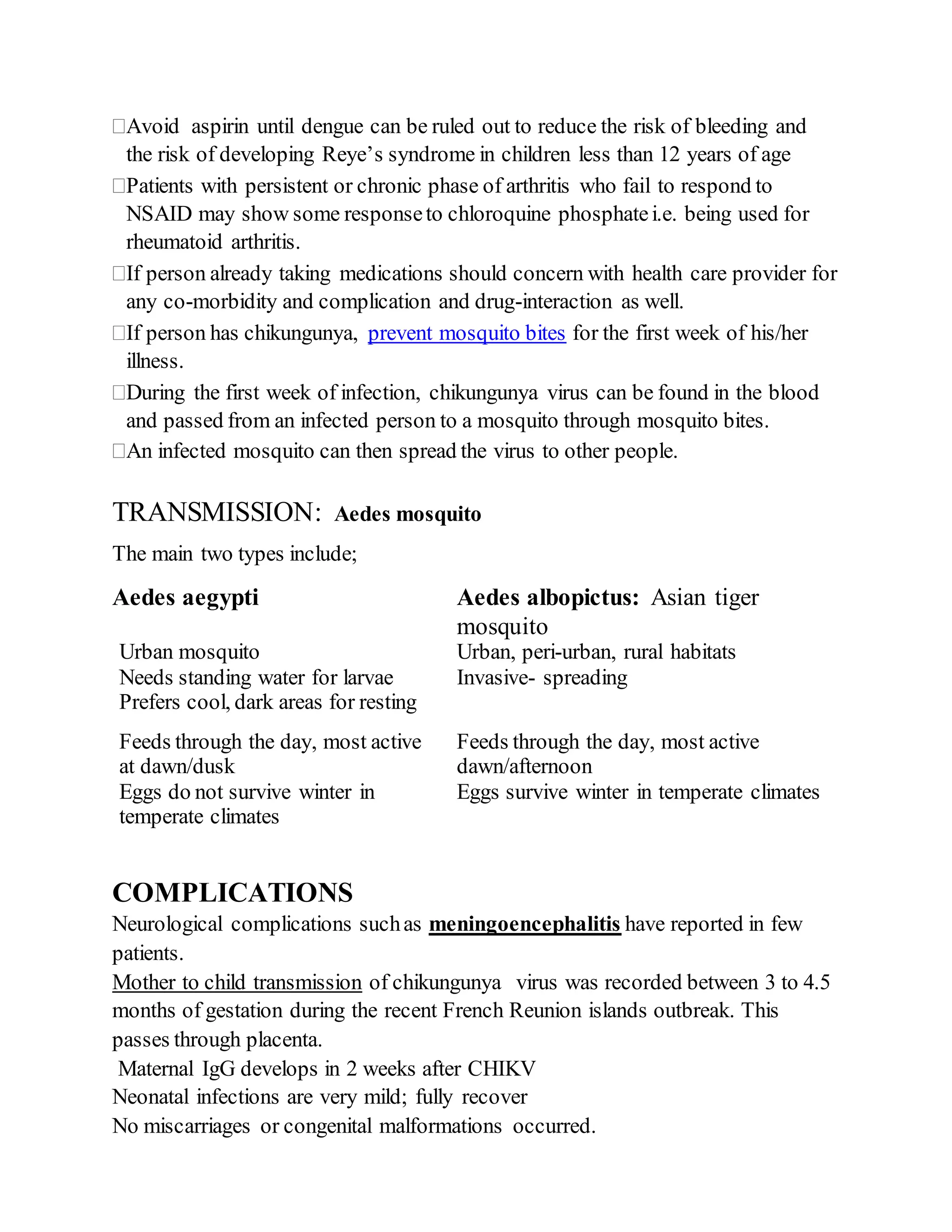The document outlines the planning, implementation, and evaluation strategies for managing chikungunya virus disease outbreaks, emphasizing prevention, detection, and response. It discusses the historical context of chikungunya, symptoms, diagnosis, treatment, and the importance of mosquito control to prevent transmission. Furthermore, it highlights the need for community involvement, health education, and multi-sectoral support in controlling the disease.




![• Anyone with a fever persisting for more than five days (indicative of another
illness like dengue).
• who develops any of the following, especially once the fever subsides:intractable
severe pain, dizziness, extreme weakness, or irritability, cold extremities,
cyanosis,decreased urine output, and any bleeding under the skin or through any
orifice. Triage at the secondarylevel (district or local hospital)
• Women in the last trimester of pregnancy, newborns, and persons with chronic
underlying disease, as they or their offsprings are at risk for more severe disease.
Triage at point of first contact(Primary or ambulatory/urgent care).
DIAGNOSIS
The symptoms of chikungunya are similar to those
of dengue and Zika, diseases spread by the same mosquitoes. But in
chickungunya there is persistent joints pain.
Diagnostic tests include virus isolation, reverse transcriptase-polymerase
chain reaction (RT-PCR), and serology.
Samples collected during the first week after onset of symptoms should be
tested by bothserological (immunoglobulin M [IgM] and G [IgG] ELISA) and
virological (RT-PCR and isolation) methods. Specimens are usually blood or
serum, but in neurological cases with meningoencephalitic features, cerebrospinal
fluid (CSF)may also be obtained.
TREATMENT AND CASE MANAGEMENT(CDC
Guidelines)
There is no vaccine to prevent or medicine to treat chikungunya virus.
Only symptomatic or supportive treatment is available:
Take good care and proper rest.
Take fluids to prevent dehydration because of heavy sweating and vomiting.
Take medicine such as acetaminophen (Tylenol®) or ibuprofen and naproxen to
reduce fever and pain.](https://image.slidesharecdn.com/pieforchikungunyavirusdisease-191218065440/75/Planning-implementation-and-evaluation-5-2048.jpg)


![ Adults: Spray insect repellent onto your hands and then apply to a child’s face.
BIOLOGICAL CONTROL
Use of larvivorous fishes Gambusia and Guppyin ornamental
tanks, fountains, etc.
Use of biocides.
CHEMICAL CONTROL
• Use of chemical organophosphorous larvicides like Abate in
big breeding containers.
• Aerosol spacespray of ultra low volume [ULV] of MALATHION or
SUMITHION 250 ml/hectare is effective in interrupting transmission and stopping
epidemics during day time. It does not affect man or the taste of water.
ENVIRONMENTAL MANAGEMENT & SOURCE REDUCTION
METHODS
• Detection & elimination of mosquito breeding sources.
• Management of rooftops, porticos and sunshades.
• Proper covering of stored water.
• Reliable water supply.
3rd phase is to promotethe individual hygiene and moving towards communities by
coordination of government and other non-government organizations.
Sensitilizing and involving the community for detection of Aedes breeding places
and their elimination
To ensure every household keeps their surrounding clean and maintains basic
hygiene
Joining hands with various NGOs to ensure that everyone has access to basic
housing facilities Making of ‘HouseSanitizer Kit’ which includes Hand Sanitizer,
mosquito repellent cream, eucalyptus oil and Insect sprays.
Promote communities to keep their surroundings clean and dumps free.
Organize ‘ResourcePooling’ where people can join together and clean the
stagnant water.](https://image.slidesharecdn.com/pieforchikungunyavirusdisease-191218065440/75/Planning-implementation-and-evaluation-8-2048.jpg)
